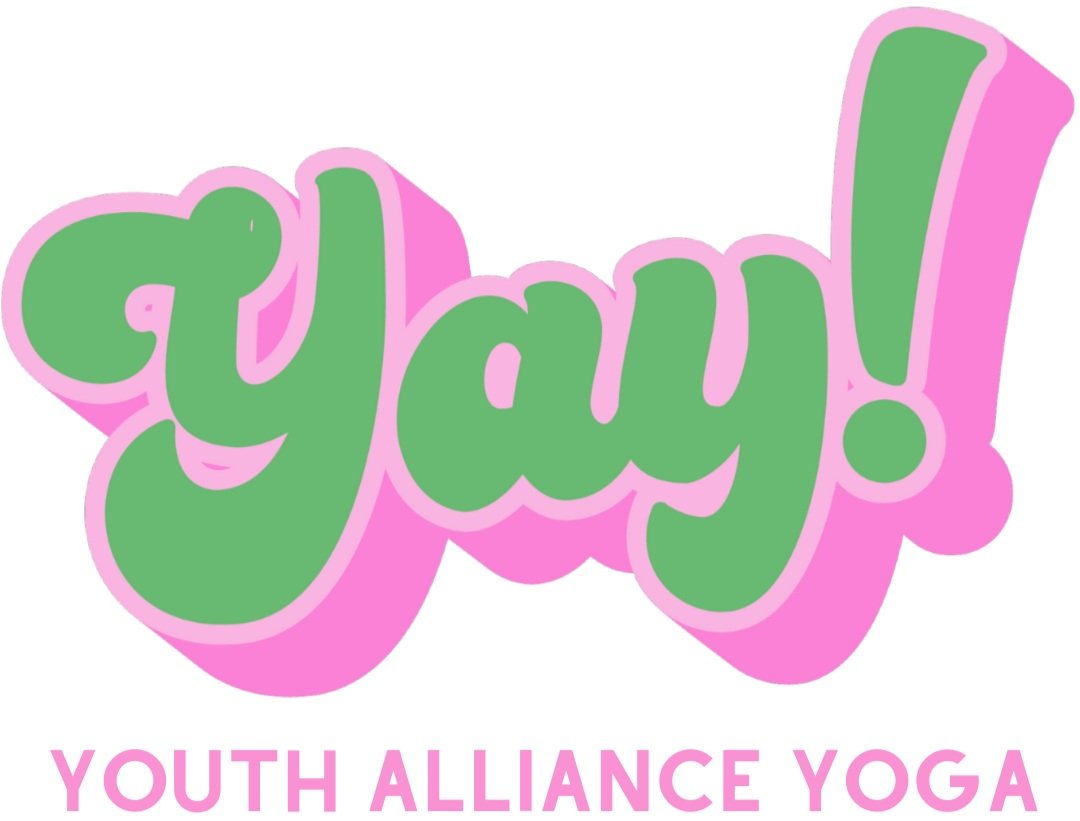Course Syllabus: Youth Alliance Yoga’s 95-Hour Teacher Training
Youth Alliance Yoga is a Registered Children’s Yoga School (RCYS). Accordingly, our program meets or exceeds all credentialing standards for 95-Hour Children’s Yoga Teacher Trainings. We are proud to offer a program with a perfect 10 on the NPS Rating Scale. If you’re thinking about enrolling, please read ALL of our RCYS Ratings — we’re proud of the trust and confidence we have built with our graduates!
Course Syllabus
Please be advised that reasonable modifications are made in order to make our program available in a virtual format.
Our virtual program is 90% asynchronous, so observations of children practicing yoga will occur via recorded videos. We do not offer live sessions with children as part of this training due to legal liability, labor laws, and privacy concerns for families.
YOGA PHILOSOPHY, LIFESTYLE & ETHICS (YPLE)
YPLE-1: THE EIGHT LIMBS OF YOGA
Instructors will explore the 8 limbs of yoga and their applicability to children's yoga.
YPLE-2: YOGA PRECEPTS FOR ETHICAL LIVING: YAMAS AND NIYAMAS
Through direct instruction, participants will learn the yoga precepts for ethical living (yamas and niyamas). Participants will build a children’s yoga class around one yama or niyama.
YPLE-3: LAW & BUSINESS OF CHILDREN’S YOGA
Through direct instruction, participants will learn the current legislative, YA, and governmental policies that impact teaching yoga to children. This lecture will place specific emphasis on the law and business of children’s yoga in educational settings, public institutions, and private entities.
YPLE-4: ETHICAL ASSISTS & ADJUSTMENTS
Participants will learn the basics of ethical language and conduct in the presence of children and their families.
GENERAL BACKGROUND OF CHILDREN’S YOGA (GBC)
GBC-1: DEVELOPMENTAL CONSIDERATIONS: CHILDREN AGES 2-18
Through direct instruction, participants will learn about the developmental stages and milestones of children in three cohorts: Early Childhood (ages 18 months-4 years), Elementary (ages 5-11), and Adolescence (ages 12-18). While gaining insights on growth stages, participants will learn how to tailor instructional methodologies to meet the needs of each age group. This session will be delivered in three units and will focus on the following:
- Early Childhood: nurture creativity, improve motor skill development, and unlock emotional awareness
- Elementary: nurture independence, improve balance and coordination, and increase awareness and management of emotions
- Adolescence: nurture self-confidence, improve physical discipline, and foster involution
GBC-2: ENGAGING WITH FAMILIES
Through direct instruction, participants will gain the communication skills to cultivate strong, positive relationships with parents/caretakers that support their child’s development. Participants will also study myths and stereotypes surrounding yoga and learn about what is appropriate, ethical, and lawful in a school setting. Finally, participants will learn how to lead a family yoga class for mixed ages.
TECHNIQUES, TRAINING, AND PRACTICE (TTP)
TTP-1: ASANA
Participants will engage in an asana workshop, exploring pose categories (prone, supine, kneeling, seated, standing) as well as movement variations (twists, bends, inversions) and prop integration (blocks, straps, bolsters, wedges, sandbags, blankets). Participants will explore appropriate modifications, assists, and sequences to accommodate the physiological abilities and/or limitations common among children ages 18 months-18 years.
TTP-2: MUDRAS
Through direct instruction, participants will learn the history and uses of mudras since the origin of yoga. Then, they will engage in a hands-on workshop exploring modern, kid-friendly applications of mudras that incorporate narrative and chants/songs.
TTP-3: MANTRAS AND CHANTING
Following a lecture on the history and uses of mantras and chants, participants will exercise their vocal instruments while learning kid-friendly mantras and songs that link breath, movement, and storytelling.
TTP-4: PRANAYAMA
Participants will engage in a lecture on the physiology, history, and applications of pranayama and explore fun and practical applications of breathwork.
TTP-5: VINYASA
Through modeling and practice, participants will learn how to adapt and create vinyasa flows for children.
TTP-6: YOGA GAMES
Through modeling and practice, participants will learn more than 25 yoga games. Participants will explore the contexts and advance preparation required for implementing yoga games with ages 18 months-18 years.
TTP-7: MEDITATION
Participants will engage in meditation practices appropriate for ages 18 months-18 years.
TEACHING METHODOLOGY (TM)
TM-1: CHILDREN WITH SPECIAL NEEDS
Through direct instruction, modeling, and small-group practice (as applicable in live workshops), participants will learn how to adapt lesson plans for children with special needs.
TM-2: BEHAVIOR MANAGEMENT: AGES 2-18
Participants will learn how to streamline classroom transitions and manage or preempt problem behavior with an emphasis on the needs of children in three cohorts: Early Childhood, Elementary, and Adolescence. Topics of study will include positive discipline, redirection, problem solving, and language.
TM-3: LESSON PLANNING & TIME MANAGEMENT
Through modeling and hands-on practice in live workshops, participants will learn how to construct a lesson plan that incorporates various elements of yoga practice and accounts for the age, attention span, and physical abilities of students ages 18 months-18 years.
ANATOMY & PHYSIOLOGY (AP
AP-1: PHYSICAL ANATOMY & PHYSIOLOGY
Through direct instruction interwoven into units on asana and pranayama, participants will learn the basics of anatomy and physiology. Participants will also learn about the physiological benefits of pranayama, asana, chanting, and meditation.
AP-2: ENERGY ANATOMY & PHYSIOLOGY
Through direct instruction, participants will learn about the chakras.
AP-3: MODIFICATIONS AND ADAPTATIONS FOR EVERY BODY
Through direct instruction and hands-on practice, participants will learn how to modify standard asana for children with physical limitations or instructional environments where standard asana is not possible or appropriate (i.e. classroom yoga).
PRACTICUM
P-1: CHILDREN’S YOGA OBSERVATIONS
Participants will observe six hours worth of children’s yoga classes conducted by the lead trainer(s).
P-2: GROUP TEACHING CHILDREN’S YOGA
Participants will lead children’s yoga classes in live workshops.
P-3: INDIVIDUAL TEACHING
Participants will individually lead children’s yoga classes. These will be recorded and submitted independently under the guidance of lead trainers.
Lingering questions? Let us know! jill@missionpropelle.com
